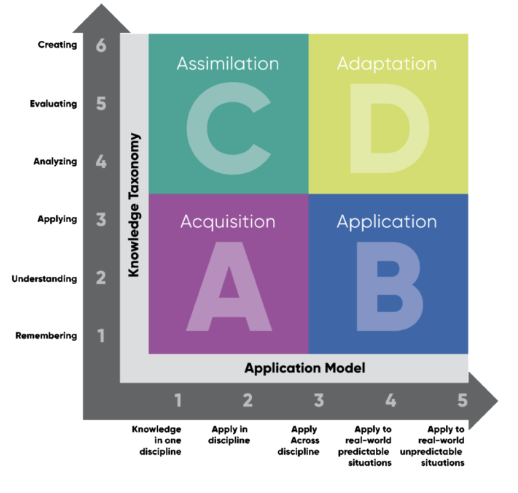As an instructional leader, I have been in many classrooms where technology use is not well planned or requires a lower level of thinking from the student. One teacher may use Kahoot at the end of the period to fill the last five minutes. Another will assign work on a Google Doc that is nothing more than a digital worksheet. In both examples, the teachers have used technology, but its use is a substitution for other tools used in the classroom, and there is no functional change in teacher instruction or student learning.
How do teachers plan for technology integration in ways that will transform the teaching and learning in their classrooms? There are several models like Puentadura’s Substitute-Augmentation- Modification- Redefinition Model (SAMR) and Mishra and Kohler’s Technological Pedagogical Content Knowledge (TPACK) model. According to Scheniger and Kieschnick (2016), both models do not consider technology’s impact on rigorous and relevant learning. They recommend using the Rigor and Relevance framework to move technology integration from teaching to empowered learning (Scheniger, 2019).

The Rigor/Relevance Framework examines curriculum, instruction, and assessment along two dimensions of higher standards and student achievement. Teachers can use this model to monitor progress by adding rigor and relevance to their instruction through technology integration.
The Rigor/Relevance Framework includes two continuums. The first is the Knowledge Taxonomy (y-axis). The continuum is based on the revised Bloom’s Taxonomy, a classification system used to define and distinguish thinking, learning, and understanding levels. On the low end of the continuum, students are acquiring knowledge and being able to recall or locate that knowledge. Students use knowledge to complete complex tasks at the high end of the continuum. The second continuum is Daggett’s Application Model (x-axis). This continuum describes the use of knowledge. Students acquire knowledge on the low end of the continuum; on the high end, students use knowledge to solve real-world problems.
Each quadrant on the Rigor/Relevance Framework identifies how students apply their learning. In Quadrant A, Acquisition, students recall information and apply that knowledge to one discipline. In Quadrant C, Assimilation, students are involved in complex thinking but still apply it in one discipline. In Quadrant B, Application, students apply knowledge across disciplines to complete real-world tasks. Whereas in Quadrant D, Adaptation, students are applying knowledge and skills to create solutions or to take action.
In reading classrooms, students engage in workshops wrapped around essential questions. Using the Rigor/Relevance Framework can help the teachers plan purposeful use of technology throughout the unit. In the first workshop, students’ big question is how do we prevent Earth’s freshwater supply from drying up? The final task asks students to argue solutions to prevent overuse or contamination of the freshwater supply. This topic is very timely for the area where we live as we deal with blue/green algae, which constantly impacts our waterways. After the workshop, students might develop a podcast to present their opinions and actions to protect the fresh water supply. This task falls into Quadrant D on the framework; students adapt information and use technology in a real-world situation to share a call to action. If this is the end task for students, we might use the remaining quadrants to consider integrating technology to prepare students for their task. First, students might use the Internet to search for information related to the question and create a bulleted list of hyperlinks in a Google Doc. The Google Doc would also be a notetaking device where students retell information they have read. These uses of technology fall into Quadrant A; students are acquiring information and using technology as a tool to capture their understanding. Next, students would use the list of hyperlinks to research information that will help them with their claim. In researching, students must summarize and analyze information. Students can then take this information to create an infographic. This use of technology is asking students to assimilate information (Quadrant C). After researching, students would generate questions to interview an expert in the field, like a professor studying water quality at Florida Gulf Coast University’s Water School or a Southwest Florida Water Management District Commissioner. The students can write about their interviews in a class blog. Students apply their knowledge and technology to create a blog (Quadrant B).
Scheniger (2019) suggests that the Rigor/Relevance Framework is a powerful leadership tool to ensure that learning is at the forefront of technology integration. The framework provides a common language and a lens through which teachers and leaders can examine how to integrate technology into curriculum, instruction, and assessment. The framework also creates a culture around a shared vision. This framework will allow teachers to integrate technology in meaningful ways and for students to use it to help them obtain, analyze, synthesize, and present information (Edutopia, 2007).
References
Edutopia. What Is Successful Technology Integration? (2007, November 5). https://www.edutopia.org/technology-integration-guide-description.
International Center for Leadership in Education (n.d). Rigor and Relevance Framework https://leadered.com/rigor-relevance-and-relationships-frameworks/.
Sheninger, E. (2019). Digital leadership: Changing paradigms for changing times. Corwin.